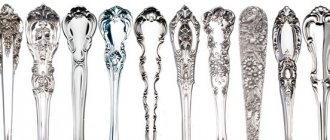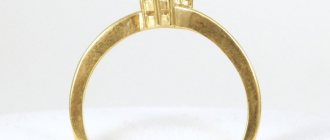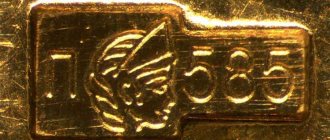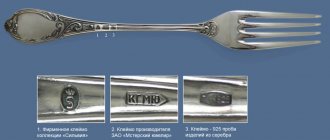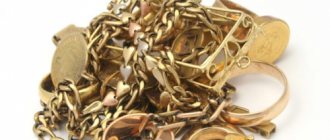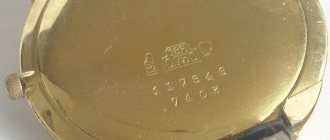“Gold jewelry” is not actually made from pure gold, but from gold-containing alloys. Gold is the main component of the gold alloy, and its share is marked by the hallmark (for example, 585 gold contains 58.5% pure gold) (more about gold hallmarks).
Additional metals included in the alloy are called alloy . Gold alloys are most often three-component: gold + silver + copper. However, in some cases the alloy may be more complex. When preparing a gold alloy, you need to take into account that some elements do not mix with each other, dividing into separate layers in the liquid state. Therefore, it may be necessary to follow a certain sequence in preparing the solution, which of course requires sufficient qualifications.
The proportion of pure gold and the ligature determine the properties that a particular alloy will have, including the shade of future gold jewelry.
The influence of different metals in the alloy on the properties of the gold alloy
Silver makes the alloy more ductile and malleable. It also changes the shade of the alloy, making it whiter. If you add more than 30% silver, the shade of the yellow alloy will become noticeably lighter, and when the amount of silver increases to 65%, the gold will turn white. When copper , the alloy becomes harder, but its anti-corrosion properties are reduced. Copper also gives the alloy a reddish tint. Cadmium makes the alloy more easily melted. It also gives the alloy a greenish tint. Zinc gives the alloy properties similar to cadmium. It brightens the alloy, which is why it is used to make white gold. A small amount of zinc can also make the alloy slightly greener. Palladium makes the alloy more refractory, forcing the heating temperature to increase. Thanks to this, the alloy becomes noticeably more ductile and lighter - palladium colors it white with a slight beige (flesh) tint. Nickel gives the gold alloy its hardness and changes the color of the alloy to pale yellow. Used as a component of white gold. Platinum bleaches gold more intensely than other alloys and increases its elasticity.
Yellowness is lost when the alloy contains about 8% platinum. Nickel, platinum and palladium also give white gold alloys high anti-corrosion properties.
Fake gold
Only a jeweler can confidently distinguish real gold from a fake, but in the meantime there is an alloy that not only contains very little precious metal, but also imitates gold. First of all, this is gold leaf, which is made from tin. The magic of golden flakes is lost if the substance is heated to a temperature of more than 500 degrees.
Titanium is a super-strong material that is used in the military, aircraft and space industries. Whether there is an alloy of gold with this element and how much titanium it contains is a question that worries people who have come across advertisements for such jewelry on the Internet.
But this is only a visual illusion, since the titanium nitride used for a thin layer of outer coating is very similar to gold plating, and there is no widespread alloy of these metals.
Gold alloys of different colors
We are all accustomed to the fact that gold can be “red”, “yellow” or “white”. However, in reality there are more shades. The table below shows possible combinations of metals when preparing gold alloys of different grades and shades. The Au column (percentage of gold content) precisely indicates the fineness of the product (58.5% is 585 fineness, and so on).
White gold
The white tint to the gold alloy is added by platinum, silver, palladium and nickel. White gold based on palladium is obtained if the proportion of this metal exceeds 16%. Palladium gives the alloy additional strength and a pale shade of natural nobility, as well as the best characteristics. True, such an alloy will be noticeably more expensive due to the high cost of palladium. A more "budget" version of white gold includes nickel , copper and some zinc.
Red gold
Copper gives the gold alloy its red tint. The usual composition of the ligature of such an alloy is silver and copper.
Blue gold
- obtained by alloying gold with iron (a rare case of a two-component alloy).
Green gold
The green tint is obtained by melting gold with silver with the addition of cadmium.
purple gold
The hue of gold can even become purple - for this you need to add aluminum, cobalt and palladium to the alloy.
In addition, it is possible to obtain a light olive tint of a gold alloy (adding tellurium), a shiny black tint (adding silver or nickel and cobalt), as well as several others.
BENDES studio jewelers tell why
In nature, gold is burdened with a number of impurities. Miners need to put in a lot of effort to extract valuable rock from the depths of the earth and rid the mineral of foreign inclusions. The resulting metal is formed into pure gold bars. In Russia, such gold is available for sale at Sberbank, and is called “bank bullion”. To be fair, it is worth noting that even here it is not entirely pure gold. The purity of the bank bullion is listed as 99.99%. This means that the quantitative content of Au (Aurum) per 1000 conventional parts is 999 parts. The remaining one part is the permissible error after cleaning the mined metal.
Colors of gold alloys depending on composition
| Alloy color | % Au (gold) | % Ag (silver) | % Cu (copper) | % Ni (nickel) | %Zn (zinc) | % Pd (palladium) | % Fe (iron) |
| Light yellow | 58,5 | 32,0 | 9,5 | — | — | — | — |
| Yellow | 58,5 75,0 | 28,0 12,2 | 13,5 12,8 | — | — | — | — |
| Dark yellow | 58,5 | 23,0 | 18,5 | — | — | — | — |
| Pink | 58,5 | 14,0 | 27,5 | — | — | — | — |
| Red | 58,5 75,0 | 7,0 6,0 | 34,5 19,0 | — | — | — | — |
| Green | 58,5 75,0 | 39,0 25,0 | 2,5 — | — | — | — | — |
| White | 58,5 58,5 75,0 | — 18,5 — | 18,5 — 5,5 | 15,5 — 15,5 | 7,5 8,0 4,0 | — 15,0 — | — — — |
| Blue | 75,0 | — | — | — | — | — | 25,0 |
Source: textbook “Jewelry Production Technology” (V.P. Lugovoy)
JEWELERY METALS - CATALOG | JEWELERY METALS - GUIDE
All about gold | All about silver | All about platinum | All about palladium
Gold hallmarks | Physico-chemical properties of gold | How to check gold for authenticity
Share this article with your friends
Works by designers from the JEWELIRUM catalog
- Co.Cos Jewelry
- Co.Cos Jewelry
- Taiga Jewelry, Tomsk
- Taiga Jewelry, Tomsk
- Ilya Maksimov, Crimea
- Ilya Maksimov, Crimea
- UBIRING
- UBIRING
- Diamonds are Forever
- Diamonds are Forever
- Rings in natural style, Sergacheva Jewelery
- Earrings with pearls, Sergacheva Jewelery
- Cabochon ring, Minty Sky
- Fly earrings, Minty Sky
- Ring, Precious Park
- Ring, Precious Park
- Snake skin ring, Stoyanova Jewelery
- Chain earrings, Stoyanova Jewelery
- Children's pendant - stick, Matthew&Daniel
- Pendant for a child, Matthew&Daniel
- Bracelet, Svetlana Subbotina
- Ring with Slavic symbols, Svetlana Subbotina
- Indian style ring, Anna Goffman
- Indian style ring, Anna Goffman
- Earrings, ISTA
- Geometric ring, ISTA
- Earrings with enamel, PNJewelry
- Ring with enamel, PNJewelry
- Ring, Khramtsova Jewelry
- Ring, Khramtsova Jewelry
- Wedding rings to order, obruchalki.com
- Wedding rings to order, obruchalki.com
- Earrings, Yuri Bylkov
- Earrings, Yuri Bylkov
- Titanium bracelets, LanaMuransky
- Titanium pendant, LanaMuransky
- Brooch Elephant (after Salvador Dali), THING
- Ring Veil, THING
- Mace earrings, VLADIMIR MARKIN
- Cufflinks, jewelry mechanics, VLADIMIR MARKIN
- Drop-shaped ring, EKATERINA TOLSTAYA
- Drop-shaped earrings, EKATERINA TOLSTAYA
- Necklace with amber, LETA
- Earrings with amber, LETA
- Children's earrings, combinable, FASHBY
- Children's earrings, combinable, FASHBY
- Ring of architectural form, Elizaveta Malafeevskaya MANU_L
- Architectural bracelet, Elizaveta Malafeevskaya MANU_L
- Set Ginkgo Leaf, SHABUT JEWELLERY
- Brooch Wearable porcelain, SHABUT JEWELLERY
- Architectural ring, GEOMETRY
- Brooch, porcelain, GEOMETRY
- Necklace made of polymer clay, LICORNE ART
- Brooch made of polymer clay, LICORNE ART
- Ring, avant-garde, VALERY SEREDIN
- Bracelet, avant-garde. VALERY SEREDIN
- Wooden set, Scandinavian/Japanese minimalism, VLADIMIR SHESTAKOV
- Ring, Scandinavian/Japanese minimalism, VLADIMIR SHESTAKOV
- Earrings, TON ANT
- Ring, TON ANT
- Architectural ring, ANCHOR
- Architectural necklace, ANCHOR
- Earrings, GOHFELD JEWELLERY
- Necklace, GOHFELD JEWELLERY
- Massive ring, YAKISCHIK
- Designer jewelry, YAKISCHIK
- Architectural ring, ONE DAY ART
- Architectural ring, ONE DAY ART
- Brooch, bionics, VALERIYA MARKOVA (TESSA)
- Unclosed ring, bionics, VALERIYA MARKOVA (TESSA)
- Ring, bionics, BEAVERS
- Earrings, bionics, BEAVERS
- Earrings, asymmetry, VAGANOVA JEWELRY
- Airplane ring, VAGANOVA JEWELRY
- Flower ring, ALCHEMIA JEWELLERY
- Set, ALCHEMIA JEWELLERY
- Pendant-cat, ethnic, STUDIO OF ILYA AND VERA PALKIN
- Earrings, STUDIO OF ILYA AND VERA PALKIN
The benefits of gold
Gold jewelry is an excellent gift for friends or relatives and a pleasant purchase for yourself. It can be stored for years and passed from mother to daughter. The gold alloys available on the market today are of high quality. There are people with individual intolerance to certain components, for example, cadmium or zinc, so it is worthwhile to find out about the composition of the alloy before purchasing, so that you do not have to resell the product later. If you have an intolerance to any of the precious metals, you can always do gold plating on the area that comes into contact with the skin, for example, on the stem of the earrings. This simple procedure will allow you to wear any metal jewelry.
Gold alloys are created to provide maximum variety to the jeweler's artistic vision. So, if in many countries only pure gold is priced, in Europe and the CIS the design and relevance of the model are valued. This is why even alloys with low gold content can be very expensive. Buy gold for yourself and your loved ones, or simply admire the beauty of this sunny metal, warming with its golden hue at any time.
Properties and structure
There has long been a concept that a compound in which silver predominates (more than 70%) is it. The same was said about other components. Electrum occupied a middle position between these metals. Current realities show that it is possible to produce products that contain less than 35% gold. Depending on the content of components in the composition, the properties of elethrum also change:
- belongs to the class of native elements;
- increased resistance to oxidation;
- high melting point;
- density - 6.5 g/cm3;
- Mohs hardness - 3 points.
The properties of the composition are not precisely described. They vary depending on the percentage of mixture components.
Ancient scriptures
The chronology has such a period as millennia BC. Many people know about this time from historical books that describe the reign of the Egyptian pharaohs. Back then, noble people on the street were distinguished from the poor by the fact that the rich wore gold jewelry.
The first nuggets of this mineral were found in East Africa on the banks of the Nile River, where Egypt is also located. Electrum was originally used to make Lydian money, as pure gold is much heavier and more fragile. And this alloy was distinguished by its lightness and wear resistance due to the presence of silver in it. It was also soft enough and amenable to forging, so they also made dishes from it. It did not oxidize, unlike iron, and was often found during excavations of the burial places of the pharaohs. The famous Cleopatra was very fond of jewelry made from this alloy.
In Ancient Egypt, alchemists who studied astrology knew 8 minerals. Among them were gold, silver, iron, copper, tin, lead, emerald and electrum. Therefore, each planet had its own metal assigned. In ancient times, the week began with Sunday, which is ruled by the Sun, and, of course, its element is gold. Monday is ruled by the Moon and holds silver. The iron was given to Mars. Mercury is associated with tin and Venus with copper. Heavy lead is attributed to Saturn.
Jupiter is considered the planet of wealth, so it rightfully received electrum, which combines three minerals at once. This can be learned from the manuscript, which is currently kept in the library of St. Mark, located in Venice.
What if you are allergic to nickel?
In the EU there is a law regulating the use of nickel in jewelry. More women react to nickel than men. There are controls on its use to prevent the occurrence of allergic reactions in people suffering from contact dermatitis.
There is no such law in the USA. If you are concerned that you may have a nickel allergy, ask for nickel-free jewelry if you choose white gold jewelry. You may need to have your jewelry made to order.


